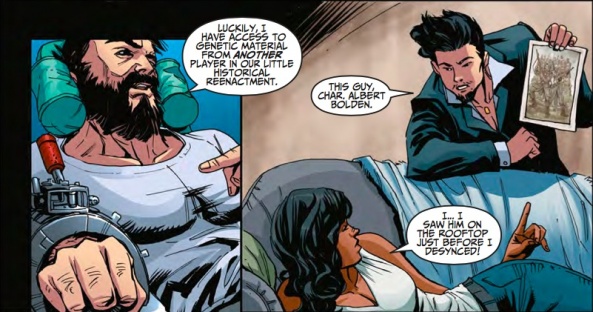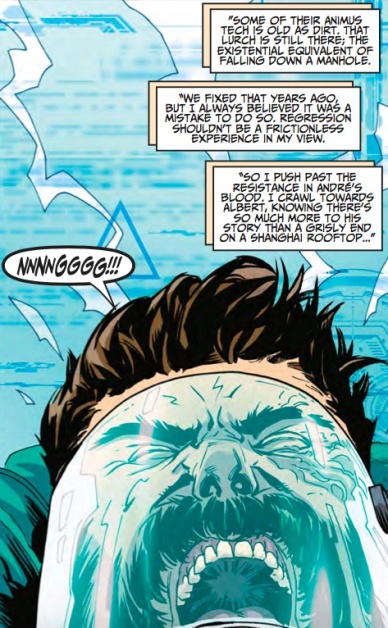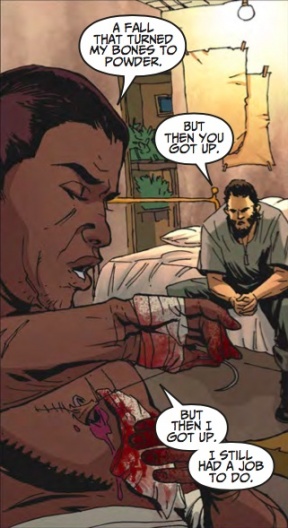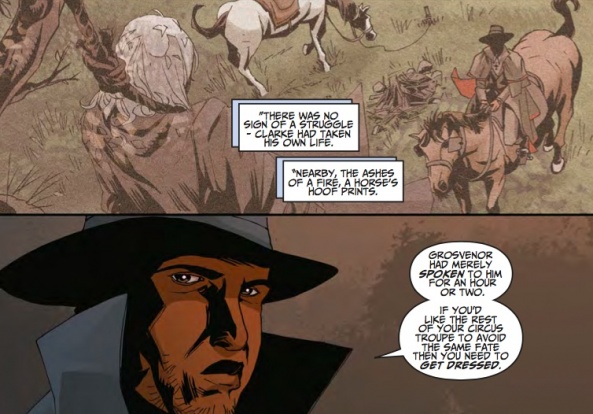Welcome back to the Isu Codices. Juhani Otso Berg’s dive back into the memories of Albert Bolden in “Assassin’s Creed: Uprising” #7 gives need for some further analysis.
New Concepts
Data Dump Scanner
The Data Dump Scanner, or “DDS,” is an advanced form of Animus technology that can make use of genetic material from someone unrelated to the user of the Animus, in order to allow them to experience memories of the donor’s ancestors, rather than their own.
Judging from the release of the first use in media being Assassin’s Creed: Project Legacy for iPhone in September 2010, it can be assumed that the technology was accessible at that point in history, or at least being tested, in use for the eponymous Project Legacy (closed down in 2012). This form of technology is used by Abstergo Industries most commonly, as they have access to much more genetic material (through blood samples and others in their shell companies). Due to the Assassin Brotherhood being primarily completely underground, they have to make do with the less advanced ancestral links.
The most abominable use of the Data Dump Scanner is most likely the Sample 17 Project. Although employees working on the project were given the fiction that “Sample 17” had been a willing donor of genetic material, he, Desmond Miles, a.k.a. “Subject 17,” had been the farthest thing from willing. His blood and saliva had been extracted post-mortem after he had saved the world from the 2012 mass coronal ejection, with him dehumanized to little more than a number and test subject for genetic analysis. There is no telling whether or not many other uses of the DDS have been under similar false pretenses.
More recent, far more devious uses of the DDS have come in the form of the Helix video game console that came through Abstergo Entertainment. That said, it is relatively unimportant to this discussion, and so will not be further discussed for now.
New Issues
Assassin’s Creed: Uprising #7

This could be a problem.
Considering how weak Charlotte “Char” de la Cruz is after witnessing Ignacio Cardona’s attempt to use the Koh-i-Noor, Black Cross Juhani Otso Berg (hereafter known as Otso Berg) takes the driver’s seat. However, it seems that even after her near-death experience, Kiyoshi Takakura is reluctant to tell her the full story on the person being analyzed, the previous Black Cross Albert Bolden. This decision seems very unwise, as it is apparent that Bolden will identify himself as a Templar soon into the memory, giving the revelation of a Templar-Assassin alliance up front. If she finds out on her own, Char might hate Takakura for his secrecy, not to mention that of Arend Schut Cunningham nearby.

Considering his connections to Abstergo Industries and his friendship with his partner, André “Dre” Bolden, he is able to get a shipment of some of the latter’s blood for use through a jury-rigged DDS setup. From the look of the way the blood vial/capsule is attached, the machine seems to either inject the blood directly (very unsafe, and thus unlikely) or analyze it for use while it is being used with the Animus itself.
Whether by coincidence or not, the use of blood with the DDS harkens back to the Observatory used from the Isu Era through to around the 18th century of the common era, which combined Piece of Eden crystal skulls with “blood vials” to have live information of what someone was seeing and hearing. The main difference is that the crystal skulls could have live data transmission, whereas the data dump scanner uses times gone past.
Either way, the transition to Bolden’s memories is by no means seamless. Berg seems to be in pain during the transition, as the technology is not built to use the DDS system. A good comparison might be an old system attempting to use new software, or new software attempting to adapt to older systems. As such, rather than falling into the memory smoothly, Berg identifies himself as “crawling” toward Albert Bolden.

Bolden’s memory starts with his “death” in 1927, then fast-forwards to him talking to the disoriented Ignacio Cardona in 1937. Bolden seems to have a superhuman resilience, as he can not only perform surgery on himself without even a grunt, but by his recollection, he was shot five times, can even remember where the bullets hit, and landed from a fall that “turned [his] bones to powder,” but still was able to not only survive, but to keep going on with his 1927 mission. Does he have Isu genetics in him, enabling his resilience much as it did for many other protagonists in the franchise?
Continued below

Bridging the Old and the New
Bolden’s explanation of the nature of “Nobby Clarke,” in actuality Rufus Grosvenor, tells much both from what he says directly and from what he does not know. Grosvenor was an acolyte of the “Master Spy,” a high-ranking German Templar who was killed by Lydia Frye in 1916 London during World War I. An important factor is the fact that the Master Spy was a Sage, one who had succumbed to Aita’s consciousness by the time of his death, and seemed to be creating a sect of the Instruments of the First Will from his supporters.
Given the fact that he seemed to want the Koh-i-Noor from Bolden despite the latter’s need to keep it safe as part of his role, he seems to have abandoned the Templars, only using them as a front as much as his role as an “Assassin” to further Juno’s efforts at totalitarianism, even seeming to hold the concept of an incipient company (likely the beginnings of Abstergo Industries) in contempt. When compared to the idea of direct control.
Furthermore, Grosvenor seems to be quite insane, as shown from the butchering of Bolden’s family to allow a distraction to steal the Koh-i-Noor from the Black Cross. However, the nightmarish fate of the
real British Assassin Norbert “Nobby” Clarke shows he is dangerous even without his battle and physical torture prowess, capable of driving the Assassin to willingly hanging himself with naught but a few hours of talking. The best comparison to find would likely be Mads Mikkelson’s interpretation of Doctor Hannibal Lecter on NBC’s
Hannibal from 2013 to 2015, a monster in a “person-suit” that can be even more dangerous than the likes of Jack the Ripper as seen in
Assassin’s Creed: Syndicate.
According to Bolden, Cardona is capable of using the Koh-i-Noor, despite the fact that many others died from attempting to do so. Beforehand, all uses of the Koh-i-Noor seemed to require the user to be biologically female, supported by his hemorrhage when he attempted to do the same. However, could a high concentration of Isu genetics, or even an internal sentience to the Koh-i-Noor (much like Consus in one of the Shrouds of Eden) override this necessity? Or is he just somewhat more resistant, and would still die if he used it too much? This implication seems to indicate that others, such as Desmond Miles’ unnamed Sage son, could potentially use the device, and it is highly likely that if she could, Juno would limit damage to a Sage using the weapon.













